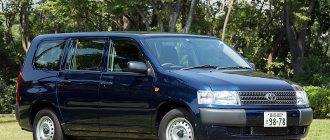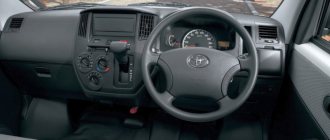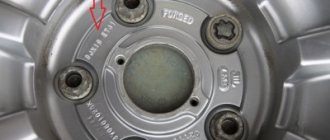Photo by user 110km.ru
There are almost 300 thousand km on the odometer, the current owner (and he, it seems, is already the third owner in the long life of the car) dotes on it, praises it in full and in detail, forgiving the invasion of rye on the doorsteps.
On-site inspection
The hood and windshield form an almost straight line, which has a beneficial effect on aerodynamics. Small headlights are supported from below by a powerful bumper of an original shape. Large foglights are built into it at the edges; they are covered with decorative protective grilles and surrounded by plastic glasses that cover the edges of the bumper and bump stop.
In case of minor “clashes”, for example, when parking, the plastic will take the blow, preserving the bumper itself, painted in a beautiful silver metallic.
The rear door lifts up and is held open by gas shock absorbers. It has a very large handle for easy opening.
There is only one sliding door to access the passenger compartment - on the left side.
The salon is very colorful. Velor is quite a cheerful color. Instrument scales are blue. The color of other parts of the interior is light gray. An unusual combination of colors, however, quite harmonious. On the driver's door trim, my attention is drawn to a black spot that houses three power window control buttons.
Yes, there is one feature here that is not typical of the vast majority of other cars: the glass of the side sliding door is lowered using an electric drive.
The cabin is very spacious. Thanks to the carriage layout, eight people can fit here (including luggage) comfortably. By the way, the seats fold easily, forming a flat platform on which you can sit for the night. Well, here’s a bonus: all seats are adjustable and have headrests. This will help you get comfortable on a long journey.
Another nice touch: the rear row seats (there are two of them, but they can accommodate three) can move back and forth relative to each other, which allows you to more widely vary the volume of the luggage compartment. And middle row passengers have access to climate control in the cabin.
The driver's seat is well equipped. Ergonomics are good, the seat is comfortable, and the driving position is close to optimal. There are no problems with visibility thanks to the very large exterior mirrors, large glass area and high seating position.
The instrument panel is more typical of a passenger car than a bus. Sitting behind the wheel, you don’t feel like you’re in a minivan at all. The instrument panel is quite informative: speedometer, tachometer, fuel level and coolant temperature gauges. The instrument scales are decorated with a blue stripe with orange divisions. The readability of instruments is excellent.
There is nothing superfluous on the center console: climate control, a CD receiver, a pocket for coins and the inevitable ashtray with a cigarette lighter.
The space between the driver and front passenger seats is free, since the automatic transmission lever is located on the steering column.
Three for one: Toyota Noah, Voxy and Esquire minivans updated
The current 2014 Toyota Noah, Voxy and Esquire minivans are variations of the same vehicle. The differences are in the design: while the Noah model is designed calmly and ordinaryly, the Voxy gives the impression of a “charged” single-volume car, and the Esquire claims to be luxurious. In addition, these models are sold in Japan by different dealer organizations - you cannot find them in one showroom. By the way, that’s why the emblems on the front are different. Otherwise, these are twins with a length of 4.7 m and a height of a full-fledged minibus: 1825 mm.
The current restyling has brought approximately the same list of changes to the cars. All three minivans now have LED headlights with horizontal bars, new bumpers, radiator grilles and taillights, and the chrome trim on the fifth door now spans the entire width of the car and is visually combined with the reversing lights. The Noah and Voxy models also have “sports” versions (Si and ZS, respectively), which are distinguished by a more aggressive front end design.
The interior has hardly changed - except that the finishing materials have been revised, and the instrument rims are now round instead of the previous truncated ones. All cars have three full rows of seats, and the second row, depending on the configuration, can have a three-seater sofa or two separate chairs, and the third row is always designed for three. That is, the capacity of minivans is seven or eight people.
If necessary, the second row seats can be moved close to the “gallery”, or even further if you fold the third row seats and fold them back, securing them along the sides. Then a rather large platform is formed between the sliding doors.
After the update, minivans now have two additional USB ports at the base of the center console, as well as a folding table mounted on the back of the front passenger seat. Sound insulation of sliding doors has been improved. And to improve comfort, body rigidity has been increased (several reinforcements have been added) and the shock absorber settings have been changed. The Toyota Esquire minivan now has the most luxurious Gi Premium Package with seats trimmed in special leather.
The power units have not changed. The base model remains a two-liter naturally aspirated engine (152 hp) with a V-belt variator, and a hybrid power unit with a 1.8 petrol “four” (99 hp), an electric motor (82 hp) and an electromechanical variator is also offered. The traction battery in this case is located under the front seats and does not affect the capacity and transformation capabilities. All-wheel drive is offered at extra cost only for regular petrol versions.
In Japan, the updated Noah, Voxy and Esquire will go on sale at the end of this week. Prices for the first two models start at $22,300, while the luxury Esquire starts at $24,100. By the way, the Toyota Voxy holds the title of the best-selling full-size minivan in the local market: 92 thousand cars last year. And together these three found 192 thousand buyers! To understand the scale: only 86 thousand Lada Granta cars were purchased in Russia last year, and this is one of the most popular cars on our market.
Let's go
Diesel can't be fast. This would seem to be the general rule. But the Japanese rarely play by the rules. As, for example, in this case. Knowing that under the hood there is a 2.2 liter turbodiesel with a capacity of 91 “horses”, I did not expect decent dynamics. And, as it turned out, in vain. In response to pressing the gas pedal, Noah sat down slightly on the rear wheels and quickly rushed forward. At the same time, the characteristic diesel rattling was not observed at all.
The car picks up speed very well from a standstill. Gear shifts smoothly, almost imperceptibly. The engine is torquey at low speeds, and at about 2,200 rpm there is a sense of pickup, and acceleration by minivan standards becomes downright fun.
Driving on the highway is pure pleasure. Noah handles the road well. It also fits well into gentle turns. All-wheel drive holds the car confidently. However, I do not dare to take provocative actions. The high center of gravity quickly cools the ardor - the body rolls noticeably when cornering.
The soft suspension is conducive to high-speed driving in a straight line. The car rocks gently on a long-travel suspension. The ride comfort exceeded all my expectations.
Noah does not notice minor coating defects. Even at high speeds (about 150 km/h), the cabin is quiet: the engine is barely audible, and aerodynamic noise begins to annoy only at speeds close to maximum.
The steering performed very well. Despite the presence of a very powerful hydraulic booster, feedback at high speed is felt excellent. And there is no trace of the “thoughtfulness” inherent in some cars. This is largely due to the short wheelbase, which makes the car more maneuverable and sensitive to steering inputs.
I did not fail to check the off-road properties of the car. Of course, Noah is far from a full-fledged SUV. A slightly increased ground clearance will never replace a multiplier and at least one hard lock, even an interaxle one. Alas, Noah has neither downshifts nor locking.
Therefore, its destiny is light soil after rain and small slopes. In such conditions, the car behaves with dignity, and the rear suspension has large compression and rebound strokes.
Be careful, the doors are sliding!
To get inside, you will have to use the sliding doors, fortunately they are on both sides of the car. The right door, on the side where the driver sits, opens manually, the opposite door opens electrically. And there is a small curiosity in this.
The fact is that in right-hand drive Japan, the homeland of Noah, the right door is, as it were, secondary, because the left side is used to take passengers on board, it is exactly electric. With us, as you understand, it’s exactly the opposite, which is why it’s a little inconvenient. The current owner of Noah has not heard of cases where craftsmen moved the motor from one door to another.
The appearance of the car is purely Asian, in the spirit of that time. There is not much beauty in the body; the “face” does not look very friendly at all, perhaps even menacing. But people don’t love a car based on aesthetics – it has many other advantages, which, as we see it, are a priority.
The first, for example, is the price. The vast majority of Noah options offered in the east of the country cost up to 500 thousand rubles. The mass of offers is up to 400 thousand. Is it reasonable? More than. The mileages are different - there are 150 thousand km, and there are more than 300 thousand. As you know, with old cars it is not the age that is important, but the condition - that everything spins, opens, if possible, does not rattle, etc.
Our test version is still a tough nut to crack. In terms of bodywork and “technique”, almost everything is original. The same goes for the interior, including convertible seats in the second and third rows. The middle ones fold, maybe not as masterfully as in the Honda Fit, but still. The rear ones are suspended vertically from the walls of the luggage compartment, providing it with additional liters (if desired, you can even walk at an angle). The third row is relatively spacious, although there is an issue with the low backrest. But ventilation is provided for all rows.
Photo: drom.ru
Photo: drom.ru
Photo: drom.ru
Photo: drom.ru
Photo: drom.ru
Photo: drom.ru
The front seats are mechanically adjustable, bulky in size, but not entirely acceptable in anatomy. At the same time, they have luxurious visibility in all directions, even despite the thick front side pillars without airbags built into them. The automatic transmission control is under the steering wheel, and all the instruments are in the center. Frankly speaking, it’s not very convenient - it takes some getting used to. There are many glove compartments and all kinds of niches, as befits a good family car.
There are 2 mobile cup holders hidden under the climate zone, and next to it there is the same ashtray that retracts into the body of the panel. At the very bottom is a USB port. On top, behind the steering wheel, there is an opening glove compartment, in front of the passenger on the left there are 2 large drawers. There is no tunnel beard, but both chairs have 2 thin armrests. The plastic of the “tidy” and the entire design around it is simple and unremarkable, but it’s easy to wash off dirt from it, nothing remains. The ceiling is high, and this gives a feeling of even greater internal space.
Comparing with "classmates"
This market segment is gradually becoming saturated. This is understandable - a universal mode of transport cannot remain unclaimed. But the Toyota Noah ($8,500)* still has few full-fledged “classmates”. On our streets you can only find Mazda Bongo Friende ($9,000) and Nissan Largo ($6,160). Close in spirit to our guest today is the Mazda MPV (no data).
* The average offer price is indicated according to the block of free private advertisements of the newspaper “Wheels” at the time of publication of the article
Evgeniy KARIMOV. Photo by Konstantin BATSAZOV
up
Brief pedigree
In advertisements for sale, people unknowingly translate the Latin letters Noah into Russian “Noah”. It sounds somehow wrong, and it’s not true, say seaside experts. More correctly, according to them, it would be “Noah” - in consonance with the same biblical hero who saved humanity from the global flood.
This option is the first generation of the car, which at the dawn of the 2000s replaced the Town Ace carriage van. Toyota also had a related Lite Ace, but it was replaced by Voxy, perhaps more famous in our European spaces. Those cars were rear-wheel drive, but when designing Noah, the focus was on the front axle.
The length of the Noah is 4.6 meters, that is, it is slightly shorter than the Ace, and this does not give it the right to be considered a full-fledged minibus, even despite the 3-row interior layout, designed to transport 8 passengers.
Make yourself comfortable!
So, sofa number one. It consists of two parts: one wide for three people, the second narrow for one. Each of the parts is mounted on separate slides, so they can be moved back and forth independently of each other. You can also independently adjust the angles of the backrests. The side single section folds down to provide access to sofa number two.
It can also accommodate three adults and consists of two identical parts. Each of them can also be moved back and forth and the back angle can be adjusted separately. In addition, the rear sofa can be folded in such a way that both halves stand at attention along the walls, and we get a huge cargo space, but with five passenger seats.
However, even with the rear sofa unfolded, we had enough space for all the necessary luggage: bags of food, a barbecue, a pot of marinated meat, a box of saxaul; there was also room for a tent. But a set of six folding chairs-chaise lounges and the same folding I had to leave the table at home. Not the boyars, tea, let's sit on the grass in nature.
Ship's equanimity
The pleasant hassle of getting ready is over, the tank is filled to capacity with diesel fuel, and we are already on our way. The first thing that struck me was the ship's composure of the Lite Ace Noah when driving on the highway. It feels like under the flat “deck” floor of the cabin there is not a car suspension, but an air cushion that almost completely smoothes out the asphalt waves.
At low speeds when driving on city streets, this effect is not as noticeable as on a country highway, when the speedometer needle approaches 150 km/h. And this is the case with a rather large minivan, almost a bus, with a 2.2-liter turbodiesel!
We had not driven even ten kilometers from the city when the distinct popping sounds of opening beer cans were heard behind me. These friends began the process of relaxing on the road. So my neighbor - the front passenger - decided to join their cheerful company and deftly slipped back between the seats. The floor between them is flat (the gearshift lever is located on the steering column) - I don’t want to walk around the cabin.
Journey through the cabin
I pretend that I don’t care about the seductive smell of beer or the “betrayal” of the front passenger. I focus on driving and studying the interior in detail. I feel like the captain of a small but richly equipped yacht. My “captain's bridge” is located high up, everything is clearly visible from it. Full speed ahead!
The gray plastic trim is successfully complemented by colorful soft fabric - it not only covers all the seats, but also decorates the door panels. By the way, electric windows are available not only on the front hinged doors, but also on the rear sliding doors. The instrument panel is uncomplicated, all its symbols are clear, and the dials please the eye not only with clear graduations, but also with a pleasant blue color.
On the left of the steering column sticks out a gearshift lever of a very intricate shape. On the center console there is a “weather in the house” control unit, an audio system and a convenient container for various small things. This is where I’ll probably end my journey through the Lite Ace Noah salon. After all, a beautiful landscape opens up outside the windows, it’s time to look for a place for a picnic.
With a slight movement of my hand I direct our tourist “liner” away from the asphalt. The group in the salon perked up and began making tricky remarks, saying, be careful on the bumps, don’t spill our beer.
But Noah overcomes several small bumps effortlessly, only slightly swaying his body. There is a larger bump ahead - I move the gear selector lever to the “L” position, add gas, and the car confidently moves forward, making its way between the trees to a sunlit clearing.
The journey is over, spread the blanket, take out the food, the picnic begins...
Konstantin BATSAZOV. Photo by the author
up
Test drive Toyota Noah. Review of the Toyota Noah, Toyota Voxy
General
Toyota's new minivans, namely the Voxy and Noah, are known to be developed on the basis of the Lite Ace Noah and Town Ace Noah cars and are included in the so-called 5th category of “single-volume vehicles” according to the internal Japanese classification. Until now, the Lite Ace and Town Ace were classified as carriage-style cargo vans, looked almost identical and were rear-wheel drive only. Now these are passenger cars with front-wheel drive, which intend to compete with the unsurpassed champion in this weight, Honda Stepwgn, and then with a number of cars led by the Nissan Serena.
The rear suspension of the cars in its main parts is the same as on the Toyota Ipsum car, namely, a torsion bar type with a trailing arm. The 2-liter 1AZ-FSE 4-cylinder gasoline engine is used in the latest Toyota models such as Vista Ardeo, Gaia and Nadia.
What's the difference between Voxy and Noah? Now this is no longer due to differences in the chassis, as was previously the case with the Lite Ace and Town Ace models. They just have a different front end design from each other, starting with the front fenders. It was planned that the design of the Voxy model would attract the attention primarily of drivers from 20 to 30 years old, and the Noah would be more popular among buyers over 30. In fact, it turned out a little differently: the behavior of buyers under 50 turned out to be predictable, but those over 60, on the contrary, liked the straight lines of Voxy cars, which greatly amused its developers. The driver's position is similar to that of an average minivan.
The main benefit from switching to front-wheel drive is that it becomes possible to significantly lower the floor level and, accordingly, increase interior volume. The floor height in front of the driver's seat is 440 mm, which is 75 mm lower than on a rear-wheel drive car. This is not as low as the Honda Stepwgn with its 420 mm, but still at the level of modern single-volume passenger cars. In addition, the driver's seating position has been lowered by 65 mm. According to the developers, from a technical point of view, the landing could have been made even lower, but this would have created certain inconveniences in driving for short drivers, for example, for women. Therefore, the driver’s seating position was calculated in such a way that its height allows maintaining a good overview, which largely determines the attractiveness of driving a minivan. In other words, unlike the low driving position in the Honda Stepwgn, which is no different from the seating position in a passenger car, in the Voxy or Noah you feel like you are in an average minivan.
As for adjusting the position of the seats, in the second row there can be two types of seats. First, it is a seat that can be rotated 180 degrees so that you can sit face to face with the person sitting in the third row (the so-called fully reclining seat). Or it will be one that can be lifted and folded easily (the chair can be easily turned over). In the third row, the seats are installed not on skids, as, for example, in the Serena car, but according to the type of seats in the Stepwgn, i.e. retractable by lifting left and right. Of course, this is one step short of the Stepwgn chairs, which are designed to allow for various types of adjustment. But my personal point of view is that the Voxy / Noah seats are quite comfortable, taking into account the important fact that the car body has sliding doors on both sides.
In low minivans such as the Honda Stream or Toyota Corolla Spacio, the third-row seats are of an auxiliary nature, the need for which arises, figuratively speaking, once every hundred years. But Voxy / Noah have a raised layout, which means their interiors are roomy enough to consider the third row of seats as normal passenger seats, which will be used much more often. And since this is a “single-volume” vehicle of the fifth category, it simply must accommodate 6-7 people. Consequently, the distribution of usable area has to be thought out with special care. I recommend a regular suspension without TEMS system
I continue the description of the chassis. As already noted, the engine on all cars of these models is the same. But there are two types of suspension. This is a regular suspension and a TEMS type suspension with increased smoothness. For a more complete assessment, I had to try both types of suspension, both in front-wheel drive mode and in 4WD mode, for a total of 4 types of driving. I first chose the Noah model with front-wheel drive and TEMS suspension. The first impression from the start of the ride is that there is no unnecessary roll. That is, the car, despite its elevated “stature,” behaves almost flawlessly. Resistance to lateral slip is no worse than that of the Honda Stepwgn. The level of comfort by the standards of a purely passenger car is quite high. Such balanced handling for a minivan is a distinctive feature of all the latest Toyota models.
After that, I get into a car with a conventional type of suspension. I can only hear a tapping sound, but I don’t feel any need for three-stage adjustment of the suspension, which becomes possible thanks to the TEMS system. Quite the contrary, when TEMS is operating, no matter what mode you turn on, you always get the impression that the suspension starts to work somehow chaotically. But this device is offered as an option for the Noah model for 70 thousand yen, and on the Voxy model it is included in the kit for some modifications. For example, the Voxy model of category Z. Everything about it is good, including discharge lamps for the headlights, parts that improve the aerodynamics of the body, etc., etc. But for me, if it were also without TEMS, but cheaper, it would be absolutely wonderful! This would be the best option for a young man between 20 and 30 years old.
Source:
CARVIEW.CO.JP
Translation:
Drom.ru When reprinting, a link to the sources of text and translation is required!
The model was equipped with one of two engines: a 2-liter gasoline engine and a 2.2-liter turbodiesel
[img10] Toyota Lite Ace Noah is a passenger version of the increased comfort of the Japanese minibus Toyota Lite Ace.
Production of Noah began in late 1996. The model was equipped with one of two engines: a 2-liter gasoline engine and a 2.2-liter turbodiesel. Gearboxes were both mechanical and automatic. The model had rear wheel drive. Quite a few modifications were produced with permanent all-wheel drive.
In the fall of 1998, a serious modernization of the “family” took place, which affected both the exterior and the interior. The optics have changed, the instrument panel has changed. The range of power units and transmission have not changed. At the end of 2001, a generation change occurred. The new Noah is front-wheel drive.
Evgeniy KARIMOV
up










